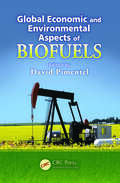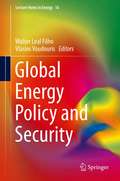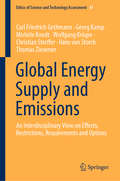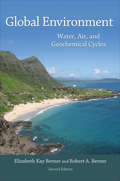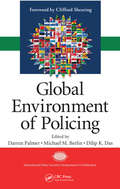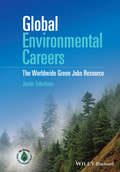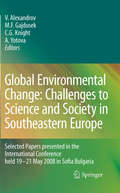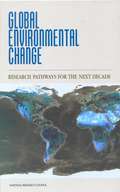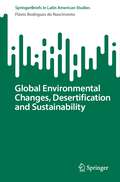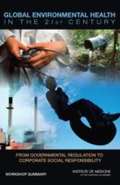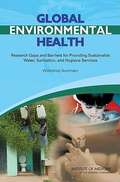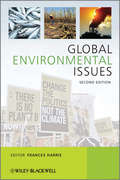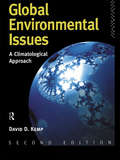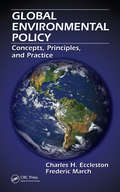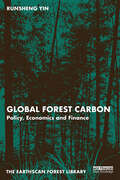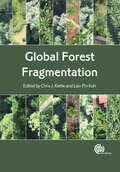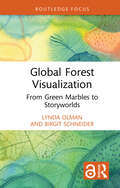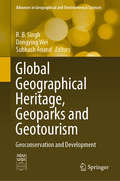- Table View
- List View
Global Ecology in Historical Perspective: Monsoon Asia and Beyond
by William Balée Kazunobu IkeyaThis book primarily examines human-animal and human-plant interactions in Asian forests (Southeast Asia and Japan) and inland waters (China). For comparison, cases from the Americas (whales in the Arctic, sea turtles in the Caribbean, and plants in the Amazon) and Central Asia are also included. The relationship between plants, animals, and humans in Asia is quite unique from a global perspective. For example, "satoyama" in Japan means ecotone area, or the boundary between a village and a forest. There, as the number of inhabitants declines, bears, wild boars, and other animals increasingly ravage crops, sometimes attacking humans as well.By showing the regional nature of human-animal and human-plant interactions in Asia, this book provides for the first time a framework for understanding the world's animal and plant-human relationships. It is assumed that the relationships between humans and animals and plants during this period were diverse, including hunting, taming, semi-domestication, and full domestication. At the same time, for regions outside of Asia, the extent to which these diverse relationships were adapted and how diversity was formed is explained from the perspective of historical ecology.Customers can expect to derive perspectives on the coexistence of human-animal and plant-animal relationships from this book in the near future.The conservation of rare species, diverse habitats, and biodiversity is a central theme in considering the relationship between modern civilization and the global environment. In post-industrial Japan, one focus has been the protection of iconic animals such as storks, crested ibis, dugongs, and sea turtles, while damage to crops and humans by deer, wild boars, monkeys, bears, and other common animals has become an important social issue. How can the world's 7.7 billion-plus people live in harmony with other species? We would like to get some hints on how to solve the problems we are facing.
Global Economic and Environmental Aspects of Biofuels
by David PimentelBiofuels and food are dependent on the same resources for production: land, water, and energy. The conjuncture of food, energy, and climate crises demands a new direction in how to harness agriculture to the joint tasks of energy-saving, emissions reduction, and food security. Global Economic and Environmental Aspects of Biofuels focuses on the all
Global Energetics of the Atmosphere: Earth–Atmosphere Equilibrium, Greenhouse Effect, and Climate Change (Springer Atmospheric Sciences)
by Boris M. SmirnovThis book looks at global atmospheric processes from a physical standpoint using available current and past observational data taken from measurements of relevant atmospheric parameters. It describes various aspects of the current atmospheric state and its future evolution, focusing primarily on the energetic balance of the Earth and atmosphere, and taking into consideration the multi-faceted global equilibrium between these two systems, carbon, and water. The analysis presented in this book restricts itself to those objects and processes that allow us to obtain reliable conclusions and numerical estimations, in contrast to current climate models with much larger numbers of parameters for describing the same problems. As a result, in spite of the roughness of numerical parameters, the book unveils a reliable and transparent physical picture of energetic phenomena in the global atmosphere. In particular, it shows that approximately only one-fourth of atmospheric water returns from the atmosphere to the Earth in the form of free molecules. It was shown that the contemporary warming of our planet has an anthropogenic character, and that the average global temperature increases due to an increase of the concentration of atmospheric CO2 molecules, via an increase in atmospheric moisture, as well as an increase in the amount of aerosols in the atmosphere. Accumulation of atmospheric carbon dioxide plays a subsidiary role in this process and gives approximately one-third in a change of the global temperature, while an increase in the amount of atmospheric water by as little as only 0.3% per year explains the observed warming of the Earth. The book shows how the greenhouse instability of the atmosphere evidently has its origins in the Eocene epoch, presenting an analysis of the influence of various types of global energetic processes on the climate that differs from the official stance on these problems.
Global Energy Policy and Security
by Vlasios Voudouris Walter LealDespite efforts to increase renewables, the global energy mix is still likely to be dominated by fossil-fuels in the foreseeable future, particularly gas for electricity and oil for land, air and sea transport. The reliance on depleting conventional oil and natural gas resources and the geographic distribution of these reserves can have geopolitical implications for energy importers and exporters. Global Energy Policy and Security examines the security of global and national energy supplies, as well as the sensitivity and impacts of sustainable energy policies which emphasize the various political, economic, technological, financial and social factors that influence energy supply, demand and security. Multidisciplinary perspectives provide the interrelated topics of energy security and energy policy within a rapidly changing socio-political and technological landscape during the 21st century. Included are two main types of interdisciplinary papers. One set of papers deals with technical aspects of energy efficiency, renewable energy and the use of tariffs. The other set of papers focuses on social, economic or political issues related to energy security and policy, also describing research, practical projects and other concrete initiatives being performed in different parts of the world. This book will prove useful to all those students and researchers interested in the connections between energy production, energy use, energy security and the role of energy policies.
Global Energy Supply and Emissions: An Interdisciplinary View on Effects, Restrictions, Requirements and Options (Ethics of Science and Technology Assessment #47)
by Wolfgang Kröger Thomas Ziesemer Georg Kamp Michèle Knodt Carl Friedrich Gethmann Christian Streffer Hans von StorchThis book offers an authoritative analysis of the state-of-the art in energy and climate research and policy. It starts by describing the current status of technologies that are expected to have an influence on the energy systems of the future. For an adequate evaluation, it presents the latest findings on the effects of energy supply and consumption as well as of the emissions on both the environment and people’s health. This is followed by an extensive discussion of the economic and social problems related to climate change, the need for energy transitions, and other issues that may require public investment and international agreements. The book reviews the problem of energy policy from a global perspective, providing readers with the technical, political, economic and ethical background needed to understand the current situation and work at better solutions for a sustainable, just and prospering world.
Global Environment
by Elizabeth Kay Berner Robert A. BernerThis newly revised edition of Global Environment discusses the major elements of the geochemical cycles and global fluxes found in the atmosphere, land, lakes, rivers, biota, and oceans, as well as the human effects on these fluxes. Retaining the strengths of the original edition while incorporating the latest discoveries, this textbook takes an integrated, multidisciplinary, and global approach to geochemistry and environmental problems and introduces fundamental concepts of meteorology, surficial geology (weathering, erosion, and sedimentation), biogeochemistry, limnology, and oceanography. New concepts and information in this updated edition include changes of atmospheric carbon dioxide over geologic time, major advances in the study of chemical weathering of rocks, ocean acidification, and important environmental problems, such as the amelioration of the acid rain problem due to reduction in sulfur deposition, problems with nitrification of soils and lakes, and eutrophication of rivers and estuaries. An expanded chapter explores atmospheric chemistry and changing climate, with the most up-to-date statistics on CO2, the carbon cycle, other greenhouse gases, and the ozone hole. Only requiring a fundamental understanding in elementary chemistry, yet taking into account extensive and current data, this text is ideal for students in environmental geochemistry, environmental geology, global change, biogeochemistry, water pollution, geochemical cycles, chemical oceanography, and geohydrology, and serves as a valuable reference for researchers working on global geochemical and environmental issues.Revised edition takes a close look at global fluxes involving the atmosphere, land, lakes, rivers, biota, and oceans, and the human effects on these fluxes Detailed discussion of basic concepts including meteorology, surficial geology (weathering, erosion, and sedimentation), biogeochemistry, limnology, and oceanography An expanded up-to-date chapter on atmospheric chemistry and changing climate, including CO2, other greenhouse gases, and ozone Presentation of major advances in the study of chemical weathering Discussion of current environmental topics Global coverage of environmental problems involving water
Global Environment of Policing (International Police Executive Symposium Co-publications)
by Dilip K. Das Darren Palmer Michael M. BerlinPolice organizations across the globe are experiencing major changes. Many nations cope with funding constraints as pressures within their societies, terrorism and transnational crime, and social and political transformations necessitate a more democratic form of policing. Drawn from the proceedings at the International Police Executive Symposium i
Global Environmental Careers: The Worldwide Green Jobs Resource
by Justin TaberhamGlobal Environmental Careers Global Environmental Careers – The Worldwide Green Jobs Resource This book is the ideal guide to equipping you with the tools and know-how to develop an environmental career. It is filled with practical advice, case studies, personal profiles and top tips across the global environment sector. An essential resource for anyone, from school students to those who are already in work but dreaming of a more meaningful career. ‘This new book comes at exactly the right moment. There has never been a more critical time for effective, international action on our common ecological crisis, and success in that work requires a new generation of 21st Century environmental professionals.’Kevin Doyle, Executive Director, Office of Career and Professional Development, Yale School of the Environment ‘As an experienced green career coach, the top questions I hear from green job seekers are, “What are the green jobs out there, which ones would be a good match, how do I get my foot in the door, and where do I find these jobs?” Taberham’s book answers all of these in a refreshingly approachable way.’Lisa Yee-Litzenberg, President, Green Career Advisor LLC ‘One of the biggest challenges environmental career seekers face is understanding and muddling through the opportunities available to them based on their experience, education, and interest. Taberham’s book is a great resource to help people navigate their options and grab some tips for the career journey.’Laura Thorne, The Environmental Career Coach ‘A fantastic book for those who are interested in pursuing a role in sustainability. Jam-packed with helpful resources, career insights, and real-life case studies this is a go-to resource for professionals who are launching their careers.’Sharmila Singh, New Lens Consulting ‘Justin Taberham provides an impressive global overview of a multifaceted, ever-changing sector that continues to evolve rapidly due to advances in technology and knowledge, changes in funding and incentives, and shifts in priorities and laws.’Carol L. McClelland, PhD, Author of Green Careers for Dummies
Global Environmental Change: Challenges to Science and Society in Southeastern Europe
by Antoaneta Yotova C. Gregory Knight Martin Felix Gajdusek Vesselin AlexandrovSelected papers from the International Conference "Global Environmental Change: Challenges for Science and Society in South-Eastern Europe" held 19-21 May 2008 in Sofia, Bulgaria. Covers changes in climate, land use, carbon and water cycles, air quality, etc.
Global Environmental Change: Research Pathways for the Next Decade
by National Research CouncilHow can we understand and rise to the environmental challenges of global change? One clear answer is to understand the science of global change, not solely in terms of the processes that control changes in climate and the composition of the atmosphere, but in how ecosystems and human society interact with these changes. In the last two decades of the twentieth century, a number of such research efforts--supported by computer and satellite technology--have been launched. Yet many opportunities for integration remain unexploited, and many fundamental questions remain about the earth's capacity to support a growing human population.This volume encourages a renewed commitment to understanding global change and sets a direction for research in the decade ahead. Through case studies the book explores what can be learned from the lessons of the past 20 years and what are the outstanding scientific questions. Highlights include: Research imperatives and strategies for investigators in the areas of atmospheric chemistry, climate, ecosystem studies, and human dimensions of global change.The context of climate change, including lessons to be gleaned from paleoclimatology.Human responses to--and forcing of--projected global change. This book offers a comprehensive overview of global change research to date and provides a framework for answering urgent questions.
Global Environmental Changes, Desertification and Sustainability (SpringerBriefs in Latin American Studies)
by Flávio Rodrigues do NascimentoThe book considers desertification as a cause-effect of environmental degradation that causes global environmental changes and the current climate crisis. Desertification affects sustainability and is one of the most severe socio-environmental problems on a global, regional, and local scale and in magnitude.It is a complex and interdisciplinary phenomenon with socioeconomic, historical, and ecological aspects. The book dealt with themes such as “Anthropocene and limits of balance on Earth; Global Environmental Changes, Climate Crisis; Desertification: concepts, myths, and reality; Causes and impacts in the world,” considering international technical-scientific assumptions guided by historical, practical, and conceptual issues.Currently, desertification (land degradation in arid, semi-arid, and sub-humid regions, resulting from various factors, such as climate variations and human activities) occurs in different continents and associates with land use and environmental and climate changes. This is a question of interest to the political management of the territory.The compendium goes beyond the conceptual approach and brings case studies with depth and a holistic view. Watersheds, for example, were treated as synthesis cells of environmental assessments and territorial units to develop public policies to manage natural resources and mitigate soil salinization and geochemical contamination.Besides the correlation between desertification and climate as a natural design, its harmful consequences for the planet are correlated with the most affected areas associated with poverty, environmental conflicts, and land tenure. The book considers several studies and a wealth of qualitative and quantitative data, pointing out about 3.6 billion hectares affected and more than 2.6 billion people affected worldwide.Desertification areas demand priority attention and greater scientific clarification not contaminated by other interests, surpassing the boundaries of sectorial and empirical explanation and not dissociated from natural x human processes. The book proposes to be holistic with an assessment of the totality!
Global Environmental Health In The 21st Century: From Governmental Regulation To Corporate Social Responsibility
by Institute of Medicine of the National AcademiesBiological threats like SARS and natural disasters like the tsunami in Indonesia have devastated entire regions, and quickly exhausted budgetary resources. As the field of environmental health continues to evolve, scientists and others must focus on gaining a better understanding of the links between human health and various environmental factors, and on creating new paradigms and partnerships needed to address these complex environmental health challenges facing society. Global Environmental Health in the 21st Century: From Governmental Regulations to Corporate Social Responsibility: Workshop Summary discusses the role of industry in environmental health, examines programs designed to improve the overall state of environmental health, and explores how governmental and corporate entities can collaborate to manage this industry. Stakeholders in both the public and private sectors are looking for viable solutions as the complexity of societal problems and risks associated with management and varying regulatory standards continue to increase. Global Environmental Health in the 21st Century draws critical links and provides insight into the current shape of global environmental health. The book recommends expanding environmental management systems (EMS) to encompass a more extensive global network. It also provides a complete assessment of the benefits and costs resulting from implementation of various environmental management systems.
Global Environmental Health: Research Gaps and Barriers for Providing Sustainable Water, Sanitation, and Hygiene Services - Workshop Summary
by Institute of Medicine of the National AcademiesThe issues surrounding water services are some of the most critical challenges facing not only the United States, but also the global community today. The Roundtable on Environmental Health Sciences, Research, and Medicine of the Institute of Medicine convened a workshop in October 2007, summarized in this volume, to address objectives related to Sustainable Water, Sanitation, and Hygiene Services. One of the objectives of the workshop was to think about the interdependence of environmental health and human health as connected through water. Organizations cannot discuss water without considering the interrelationship of sanitation and hygiene. It is the convergence of these strategies that promotes healthy outcomes for both individuals and the environment. A second objective of the workshop was to consider how planning, management, and interdisciplinary approaches-including technology, social behavioral issues, gender, health, environment, economic, and political aspects-can be integrated to arrive at sustainable solutions. Many organizations and agencies are trying to forge a path toward sustainable practices in water, but the various sectors utilizing and governing water services are not interconnected. More integration and a greater understanding of holistic approaches are needed.
Global Environmental Issues
by Frances HarrisGlobal Environmental Issues, second edition builds on the popularity of the first edition, viewing global environmental problems as complex issues with a network of causes, influenced by a range of actors with differing priorities. The book recognises that science underpins much of what happens in society and therefore it is important to be able to interpret the environmental and social consequences of scientific developments. In addition to discussing the main biophysical causes, the book illustrates how socio-economic and political factors determine why and how people use land, resources and technology, and how this in turn affects natural resource management.This edition includes new chapters on the politics of science, International environmental regulation and treaties, environmental issues in a globalised world and natural resource management.Global Environmental Issues, second edition is essential reading for upper level undergraduates and Masters students within departments of Environmental Science and Geography.Includes case studies from around the world to provide a real life context for the issues tackled in each chapterConsiders both the results of human actions and natural environmental change in order to provide balanced, in-depth debateIncludes coverage of contemporary 'hot topics' such as biodiversity, globalization and sustainable developmentChapters authored by experts in the fieldIncludes new chapters on The politics of science, International environmental regulation and treaties , Environmental issues in a globalised world and Natural Resource ManagementExpanded sections include negotiating multilateral environmental agreements, GM crops, biofuels and marine and freshwater resources
Global Environmental Issues: A Climatological Approach
by David KempThis book provides a balanced account of the global environmental issues which threaten our society and which we neglect at our peril. Analysing both social and environmental components of the issues - global warming, ozone depletion, acid rain and drought - the book offers a valuable integrative approach and a detailed analysis of environmental issues in a clear, non-technical manner. Emphasising the climatological dimension common to all environmental issues, Global Environmental Issues recognises the multi-faceted nature of the issues, their common causes and the possibility of common solutions. Assessment of socio-economic, cultural amd political factors provides a balanced introduction to both the dangers and advantages of human interference with the environment. What have we done to deserve our current environmental crisis? Can we solve our current environmental problems, or is it too late?This new edition of a best selling text is completely updated and expands to include greater detail and new material such as a new section on atmospheric modelling. A glossary has been added together with a bibliography for further reading at the end of each chapter, allowing readers to develop their interest in specific areas. The interdisciplinary text will prove invaluable to students in geography, environmental studies and other courses in whcih the environmental approach is emphasised.
Global Environmental Policy: Concepts, Principles, and Practice
by Charles H. Eccleston Frederic MarchEnvironmental policy is often practiced reactively with each crisis addressed as an isolated event. Focusing on development of proactive policies, Global Environment Policy: Concepts, Principles, and Practice provides the essential scientific and socioeconomic framework for formulating pragmatic and comprehensive environmental policies. It discusse
Global Ethics and Environment
by Nicholas LowAs global capitalism expands and reaches ever-further corners of the world, practical problems continue to escalate and repercussions become increasingly serious and irreversible. These practical problems carry with them equally important and ethical issues.Global Ethics and Environment explores these ethical issues from a range of perspectives and using a wide range of case studies. Chapters focus on: the impact of development in new industrial regions; the ethical relationship between human and non-human nature; the application of ethics in different cultural and institutional contexts; environmental injustice in the location of hazardous materials and processes; the ethics of the impact of a single event (Chernobyl) on the global community; the ethics of transitional institutions.This collection will both stimulate debate and provide an excellent resource for wide-ranging case study material and solid academic context.
Global Food Insecurity
by Sanni Yaya Mohamed Behnassi Sidney DragganHuman-kind and ecological systems are currently facing one of the toughest challenges: how to feed more billions of people in the future within the perspective of climate change, energy shortages, economic crises and growing competition for the use of renewable and non renewable resources. This challenge is even more crucial given that we have not yet come close to achieving the Millennium Development Goal of halving the number of people living in extreme poverty and hunger. Scientists and relevant stakeholders are now voicing a clear message: that multiple challenges the world is facing require innovative, multifaceted, science-based, technological, economic and political approaches in theoretical thinking, decision making and action. With this background central to survival and well-being, the purpose of this volume is to formulate and promote relevant theoretical analysis and policy recommendations. The major perspective of this publication is that paradigm and policy shifts at all levels are needed urgently. This is based on the evidence that agriculture in the 21st century will be undergoing significant demands, arising largely from the need to increase the global food enterprise, while adjusting and contributing to climate change adaptation and mitigation. Global Food Insecurity aims at providing structure to effect achievement of this critically needed roadmap.
Global Forensic Cultures: Making Fact and Justice in the Modern Era
by Ian Burney and Christopher HamlinEssays explore forensic science in global and historical context, opening a critical window onto contemporary debates about the universal validity of present-day genomic forensic practices.Contemporary forensic science has achieved unprecedented visibility as a compelling example of applied expertise. But the common public view—that we are living in an era of forensic deliverance, one exemplified by DNA typing—has masked the reality: that forensic science has always been unique, problematic, and contested. Global Forensic Cultures aims to rectify this problem by recognizing the universality of forensic questions and the variety of practices and institutions constructed to answer them.Groundbreaking essays written by leaders in the field address the complex and contentious histories of forensic techniques. Contributors also examine the co-evolution of these techniques with the professions creating and using them, with the systems of governance and jurisprudence in which they are used, and with the socioeconomic, political, racial, and gendered settings of that use. Exploring the profound effect of "location" (temporal and spatial) on the production and enactment of forms of forensic knowledge during the century before CSI became a household acronym, the book explores numerous related topics, including the notion of burden of proof, changing roles of experts and witnesses, the development and dissemination of forensic techniques and skills, the financial and practical constraints facing investigators, and cultures of forensics and of criminality within and against which forensic practitioners operate.Covering sites of modern and historic forensic innovation in the United States, Europe, and farther-flung imperial and global settings, these essays tell stories of blood, poison, corpses; tracking persons and attesting documents; truth-making, egregious racism, and sinister surveillance. Each chapter is a finely grained case study. Collectively, Global Forensic Cultures supplies a historical foundation for the critical appraisal of contemporary forensic institutions which has begun in the wake of DNA-based exonerations.Contributors: Bruno Bertherat, José Ramón Bertomeu Sánchez, Binyamin Blum, Ian Burney, Marcus B. Carrier, Simon A. Cole, Christopher Hamlin, Jeffrey Jentzen, Projit Bihari Mukharji, Quentin (Trais) Pearson, Mitra Sharafi, Gagan Preet Singh, Heather Wolffram
Global Forest Carbon: Policy, Economics and Finance (The Earthscan Forest Library)
by Runsheng YinThis book addresses the major policy, economic and financial issues encountered in global forest carbon.The global forest sector is expected to play a major role in achieving the Paris Agreement’s temperature targets. Therefore, there is an urgent need to explore practical and promising solutions to the challenges facing carbon accounting and policy assessment as the global community undertakes forest sector actions—including the widely known REDD+ initiative. This book demonstrates how vital it is that we identify appropriate perspectives and formulate approaches to address these challenges in an integrated and effective manner. In doing so, it addresses many of the major issues, including the differential potentials for carbon sequestration within various forest ecosystems as well as for storage within a variety of harvested wood products, the joint production of timber and carbon, and the measurement and impact of forest carbon offsets and credits, results-based payments, and other nationally determined contributions centered differences as well. The book examines regional and country-level case studies from across the world and draws on the author's decades of experience working on forest policy and with the forest sector. Overall, this book highlights the technical and policy issues regarding forest sector carbon emission and removal to build useful perspectives, frameworks, and methods for addressing these issues successfully in the future. It advances the knowledge frontiers of global forest carbon policy, economics and finance as well as the ability to assess the effectiveness, efficiency, and equity of forest climate solutions.This book is essential reading for professionals and policymakers working at the intersection of forest policy, carbon storage and climate change, as well as students and researchers in the fields of forestry, natural resource management, climate change and nature-based solutions.
Global Forest Fragmentation
by Stacy M. Stacy M. Jürgen Jürgen Bruce L. Bruce L. Ute Ute Timm F. Timm F. Lian Pin Koh Katharine J.M. Katharine J.M. Raphael K. Didham Joern Joern Panut Panut Sarah H. Sarah H. Chris Kettle Jan C. Jan C. Claude Claude Richard T. Richard T. Sarah A. Sarah A. Laurène Laurène Edgar C. Edgar C. Campbell O. Campbell O. Andrew D. Barnes Shonil Shonil Aline Finger Keith Keith Alexandra-Maria Klein Kinari Kinari Jahi Jahi Richard B. Richard B. Kelvin S.H Kelvin S.H Christopher Christopher Rhett D. Rhett D.Forest fragmentation will inevitably continue over the coming years, especially in developing economies. This book provides a cutting edge review of the multi-disciplinary sciences related to studies of global forest fragmentation. It specifically addresses cross-cutting themes from both an ecological and a social sciences perspective. The ultimate goal of Global Forest Fragmentation is to provide a detailed scientific base to support future forest landscape management and planning to meet global environmental and societal needs.
Global Forest Fragmentation
by Stacy M. Stacy M. Jürgen Jürgen Bruce L. Bruce L. Ute Ute Timm F. Timm F. Katharine J.M. Katharine J.M. Raphael K. Didham Joern Joern Panut Panut Sarah H. Sarah H. Jan C. Jan C. Claude Claude Richard T. Richard T. Sarah A. Sarah A. Laurène Laurène Edgar C. Edgar C. Campbell O. Campbell O. Andrew D. Barnes Shonil Shonil Aline Finger Keith Keith Alexandra-Maria Klein Kinari Kinari Jahi Jahi Richard B. Richard B. Kelvin S.H Kelvin S.H Christopher Christopher Rhett D. Rhett D.Forest fragmentation will inevitably continue over the coming years, especially in developing economies. This book provides a cutting edge review of the multi-disciplinary sciences related to studies of global forest fragmentation. It specifically addresses cross-cutting themes from both an ecological and a social sciences perspective. The ultimate goal of Global Forest Fragmentation is to provide a detailed scientific base to support future forest landscape management and planning to meet global environmental and societal needs.
Global Forest Governance and Climate Change: Interrogating Representation, Participation, And Decentralization (Palgrave Studies In Natural Resource Management Ser.)
by Emmanuel O. NuesiriThis edited collection assesses governance in forestry programmes and projects, including REDD+ governance. It examines political representation, participation and decentralisation in forest governance, providing insight as to how forest governance arrangements can be responsive to the socio-economic interests of local people and communities who live adjacent to and depend on forests.Global Forest Governance and Climate Change argues that inclusive complementary representation of local communities is required for strong participatory processes and democratic decentralisation of forest governance. Responsiveness to local people’s socio-economic interests in forestry initiatives require paying attention to not just the hosting of participatory meetings and activities, but also to the full cast of appointed, self-authorized, and elected representative agents that stand, speak, and act for local people. This book will be of interest to students and academics across the fields of climate change governance, forestry, development studies, and political economy. It will also be a useful resource for policy makers and practitioners responsible for forestry and climate change initiatives.
Global Forest Visualization: From Green Marbles to Storyworlds (Routledge Focus on Environment and Sustainability)
by Birgit Schneider Lynda OlmanThis book project examines global forest monitoring as a means to understand the promises and problems of global visualization for climate management.Specifically, the book focuses on Global Forest Watch, the most developed and widely available forest-monitoring platform, created in 1997 by the World Resource Institute. Forest maps are always political as they visualize power relations and form the grid within which forests become commodities. This dislocation of the idea of the forest from its literal roots in the ground has generated problems for forest visualization efforts designed to empower local communities. This book takes a critical humanistic approach to this problem, combining methods from the fields of rhetoric and media studies to suggest solutions to these problems for designers and users of platforms like the Global Forest Watch. To explain why global views of forests can be disempowering, the book relies on biopolitical and rhetorical theories of panopticism and how these views unfold a different violence on different regions of the Earth in relation to colonial history. Using this theoretical framework, the book explains the historical process by which forests came to be classified, quantified, and mapped on a global scale. Interviews with end-users of global forest visualization platforms reveal if and how these platforms support local action. Lastly, the book provides rhetorical solutions to articulate global and local views of forests without reducing one view to the other. These solutions involve looking to forests themselves for clues about how to generate more broadly effective and resilient visualizations.This book will be of great interest to students and scholars of forest studies, climate change, science communication, visualization studies, environmental communication, and environmental conservation.The Open Access version of this book, available at http://www.taylorfrancis.com, has been made available under a Creative Commons [Attribution-Non Commercial-No Derivatives (CC-BY-NC-ND)] 4.0 license.
Global Geographical Heritage, Geoparks and Geotourism: Geoconservation and Development (Advances in Geographical and Environmental Sciences)
by R. B. Singh Subhash Anand Dongying WeiThis book explores the geographical, geomorphological, ecological, touristic and socioeconomic aspects of natural heritage, argues for the dynamic conservation of that heritage and explains its key characteristics, promotion, conservation and management to achieve sustainable development goals. Emerging concepts such as geodiversity, geographical heritage sites, geomonuments, geoparks and geotourism are increasingly being used by conservationists. At present, the development of geoparks is a major global theme involving the application of geosciences to promote the inclusive growth of society and the protection and conservation of our unique geoheritage. Currently, there are 147 UNESCO global geoparks across 41 countries, in addition to a number of national-level geoparks. Pursuing a holistic approach towards such sites will sensitise the general public to the need for geoconservation of significant geosites and promote it through geotourism. It is a crucial issue, as various countries around the world are eager to develop their geoparks and are working for the conservation of geoheritage sites at the national level. This unique book gathers contributions from 15 countries in the form of case studies analysing the realities on of geographical heritage, geoparks and geotourism. The respective chapters address the role of geoparks as essential tools for education, recreation and nature conservation. Given its scope, the book offers a valuable guide for geoscientists, planners, policymakers, civil society and anyone concerned about the conservation of geoheritage sites and geoparks for a sustainable future Earth.

